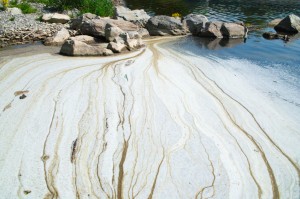By Scott H.
Scott is a two-fisted guy in New Mexico who commented about our Daily Sighting, “Bear Pressure.” He also turned us on to a website about the Gulf oil spill. See “Bears, and oil in your neighborhood.” But there’s more to Scott than bears and oil. He wrote the following piece about a little known ecological eye-opener. If you’d like additional information, use the comment box and we’ll relay your message to Scott.
The mess in the Gulf is dramatic and criminal, no one should doubt that, but there is another, ongoing bird-killing ecological train wreck that can be found in several localities out here ‘west of the hundredth.’ This is a situation that has gone on, day after day, year after year, ever since our industrial culture reached the High Plains.
The birds involved are migratory waterfowl and the killer is salt. Not so much the natural levels of salt found in isolated water bodies all around the West, but the evaporative concentrated brines that are discharged from various industrial processes, notably potash refining and petroleum extraction. These are crack-your-skin brines, fluids so concentrated that a film of crystalline salt forms on the surface on hot days. One hesitates to use the word water in association with these basins. You wear a broad brimmed hat when you work on these lakes and heavy waterproof gloves. You put sunscreen under your chin and eyebrows because the floor of these lakes is solid salt, feet thick, whiter than bleached bone and ragged with sharp salt crystals. The reflected sunlight will give you a nasty burn without protection.

Migrating waterfowl, mostly ducks and grebes, that loiter on these waters for more than a few tens of minutes are doomed. There’s no water to drink after their long flight. The salt penetrates the oil on their feathers and they begin to suffer from hypothermia. They become waterlogged and begin to ride low in the water, become too heavy to escape and soon exhaust themselves trying. They die, badly, in less than a day and sink to the bottom where they become crystalline caricatures of themselves, or they wash up onto the shore where the scavengers only sample them and leave. The bodies are too salty even for the likes of rats and skunks.
In my experience natural salt lakes don’t kill birds. Only lakes whose normal hydrologic cycles and salt loads have been disrupted become killers. Here in New Mexico these lakes are concentrated in the southeast part of the state, down in the Carlsbad Potash District and the geographically overlapping Permian Basin oil fields, but there are isolated systems of these little known killing fields stretching from New Mexico to Manitoba. They sit there out on the High Plains, largely out of sight and out of mind, luring exhausted waterfowl to their deaths in their thousands, year after year, decade after decade.
There has been some progress. As a result of work done in the early 1990s by several intrepid biologists from the US Fish and Wildlife Service, some of the offending water bodies have been cleaned up or hydrologically altered such that the bird ‘take’ has been reduced or eliminated. Too, companies began early on, under pressure, to try to haze birds landing on some of these lakes to drive them off. These efforts continue to this day on some lakes despite the continual destruction of airboats and other equipment by the corrosive action of the salt.
No one knows the exact toll on migrating populations of ducks in New Mexico, let alone nation wide, but across the High Plains the tally must reach into the thousands annually, perhaps higher.
I have years of experience with this situation as well as other issues involving more conventional playa lakes and would be happy to help educate this website’s readers about a little known aspect of our nation’s biological endowment – and sometimes tragedy. I have access to documents, raw data and people. And, being recently retired, I have time to pontificate.
This has been two-fisted work at its smelliest, grimiest best – or worst – depending on your perspective.

Fascinating. I loved the detail about applying sunscreen under the chin and eyebrows.
I would like some additional information about this and what individuals can do to help. I live in Phoenix and am curious about the existence of these deathtraps in this and other areas of the state…..